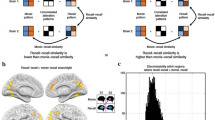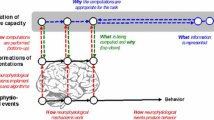Abstract
The idea that human cognitive capacities are explainable by computational models is often conjoined with the idea that, while the states postulated by such models are in fact realized by brain states, there are no type-type correlations between the states postulated by computational models and brain states (a corollary of token physicalism). I argue that these ideas are not jointly tenable. I discuss the kinds of empirical evidence available to cognitive scientists for (dis)confirming computational models of cognition and argue that none of these kinds of evidence can be relevant to a choice among competing computational models unless there are in fact type-type correlations between the states postulated by computational models and brain states. Thus, I conclude, research into the computational procedures employed in human cognition must be conducted hand-in-hand with research into the brain processes which realize those procedures.
Similar content being viewed by others
References
Churchland, P. S. (1986),Neurophilosophy, Cambridge, MA: MIT Press.
Dennett, D. (1971), ‘Intentional Systems’,Journal of Philosophy LXVIII, pp. 87–106.
Dreyfus, H. (1979),What Computers Can't Do (revised edition), New York: Colophon Books.
Ericsson, K. A. and Simon, H. A. (1980), ‘Verbal Reports as Data’,Psychological Review 87, pp. 215–251.
Flanagan, O. J. (1984),The Science of Mind, Cambridge, MA: MIT Press.
Fodor, J. A. (1981), ‘Special Sciences’,Representations, Cambridge, MA: MIT Press, pp. 127–145.
Fodor, J. A. (1983),The Modularity of Mind, Cambridge, MA: MIT Press.
Glymour, C. (1980),Theory and Evidence, Princeton: Princeton University Press.
Haugeland, J. (1983), ‘Ontological Supervenience’,Southern Journal of Philosophy 22, Supplement, pp. 1–12.
Haugeland, J. (1985),Artificial Intelligence: The Very Idea, Cambridge: MIT Press.
Haugeland, J. (1990), ‘The Intentionality All-Stars’, in J. Tomberlin, ed.,Philosophical Perspectives, 4:Action Theory and Philosophy of Mind, Atascadero, CA: Ridgeview Publishing Co., pp. 383–427.
Kim, J. (1980), ‘Physicalism and the Multiple Realizability of Mental States’, in N. Block, ed.,Readings in Philosophy of Psychology Vol. 1, Cambridge, MA: Harvard University Press, pp. 234–236.
Lewis, D. (1980a), ‘Review of Putnam’, in N. Block, ed.,Readings in Philosophy of Psychology, Vol. 1, Cambridge, MA: Harvard University Press, pp. 232–233.
Lewis, D. (1980b), ‘Psychophysical and Theoretical Identifications’, in N. Block, ed.,Readings in Philosophy of Psychology, Vol. 1, Cambridge, MA: Harvard University Press, pp. 207–215.
Lewis, D. (1980c), ‘Mad Pain and Martian Pain’, in N. Block, ed.,Readings in Philosophy of Psychology, Vol. 1, Cambridge, MA: Harvard University Press, pp. 216–222.
Miller, R.W. (1987),Fact and Method, Princeton: Princeton University Press.
Nisbett, R.E. and Wilson, T. (1977), ‘Telling More Than We Can Know: Verbal Reports on Mental Processes’,Psychological Review 84, pp. 231–259.
Pylyshyn, Z. (1978), ‘Computational Models and Empirical Constraints’,Behavioral and Brain Sciences 1, pp. 93–99.
Pylyshyn, Z. (1980), ‘Computation and Cognition: Issues in the Foundations of Cognitive Science’,Behavioral and Brain Sciences 3, pp. 111–169.
Pylyshyn, Z. (1981), ‘Complexity and the Study of Artificial and Human Intelligence’, in J. Haugeland, ed.,Mind Design, Cambridge, MA: MIT Press, pp. 67–94.
Pylyshyn, Z. (1984),Computation and Cognition, Cambridge, MA: MIT Press.
Quattrone, G. (1985), ‘On the Congruity Between Internal States and Action’,Psychological Bulletin 98, pp. 3–40.
Simon, H.A. (1978), ‘On How We Decide What to Do’,Bell Journal of Economics 9, pp. 494–507.
Simon, H. A. (1985), ‘Some Computer Models of Human Learning’, in M. Shafto, ed.,How We Know, San Francisco: Harper & Row, pp. 89–112.
Stich, S. (1983),From Folk Psychology to Cognitive Science: The Case Against Belief, Cambridge, MA: MIT Press.
Author information
Authors and Affiliations
Rights and permissions
About this article
Cite this article
Buller, D.J. Confirmation and the computational paradigm (or: Why do you think they call itartificial intelligence?). Mind Mach 3, 155–181 (1993). https://doi.org/10.1007/BF00975530
Issue Date:
DOI: https://doi.org/10.1007/BF00975530




